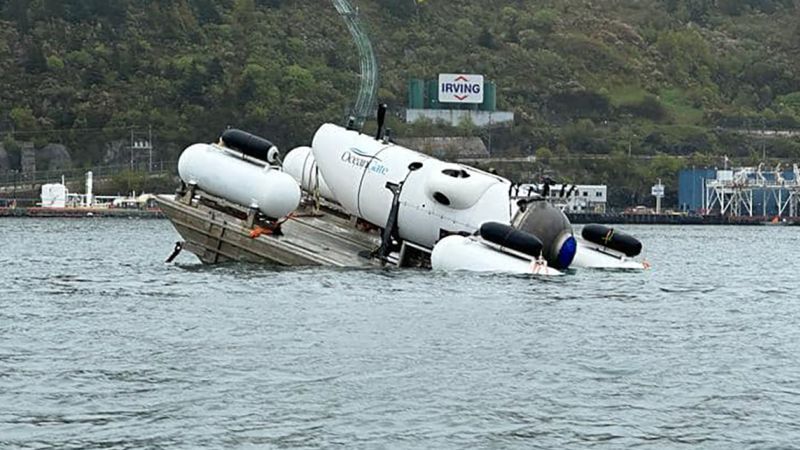What we know about the missing Titanic-exploring submersible
CNN —
A submersible carrying five people to see the remains of the Titanic at the bottom of the North Atlantic Ocean is still missing despite a massive search operation by United States and Canadian authorities.
The Titan submersible had been on its way to the famous wreckage, off the coast of St John’s, Newfoundland, in Canada, when it lost contact with its support ship, leaving the people on board with only enough oxygen for 3 to 4 days.
Here’s what we know so far.
How did they go missing?
The submersible was part of an eight-day journey conducted by OceanGate Expeditions. The trip is based out of Newfoundland, with participants first traveling 400 nautical miles to the wreck site, which is about 900 miles (1,450 kilometers) off the coast of Cape Cod, Massachusetts.
The submersible began its two-hour descent to the wreck on Sunday morning. It lost contact with the Polar Prince, the support ship that transported the vessel to the site, 1 hour and 45 minutes into its descent, officials said.
Search operations began later that day.
It’s still not clear what happened to the submersible, why it lost contact, and how close to the Titanic it was when it went missing.
Who’s on board?
The five people on board include one pilot and four “mission specialists,” said Rear Adm. John Mauger, commander of the US Coast Guard’s First District.
OceanGate CEO and founder Stockton Rush is among those onboard, according to a source with knowledge of the mission plan.
A British businessman based in the United Arab Emirates, Hamish Harding, is also onboard, according to a social media post by the company he owns, Action Aviation.
“The sub had a successful launch and Hamish is currently diving,” the company said in an Instagram post on Sunday.
Harding was one of the first people to travel the Challenger Deep in the Pacific Ocean – the deepest known point on Earth.
On Saturday he wrote of the Titanic mission: “I am proud to finally announce that I joined OceanGate Expeditions for their RMS TITANIC Mission as a mission specialist on the sub going down to the Titanic.”
Hamish Harding posted an image of the submersible to his social media accounts on June 17. From Hamish Harding/Facebook
Harding had posted on social media Saturday saying that diver Paul-Henri Nargeolet was scheduled to be on Sunday’s dive with him. Nargeolet has led several expeditions to the Titanic and supervised the recovery of many artifacts from the wreck, according to the E/M Group, where Nargeolet was director of underwater research.
CNN has attempted to reach out independently to Nargeolet with no success.
A Pakistani businessman, Shahzada Dawood, and his son Sulaiman Dawood, were also on board, according to a statement released by the family on Tuesday. Contact has been lost and there is limited information available, it said.
Shahzada Dawood is a trustee of the SETI Institute, a research organization in California, according to its website. He is also vice chairman of Dawood Hercules Corporation, part of the Dawood Group, a conglomerate of various businesses owned by the family.
Authorities have not publicly identified the passengers on board, and said Monday they are still notifying their families.
The OceanGate website says its expeditions, which cost upwards of $250,000, typically involve one pilot, a “content expert” and three paying passengers.
How much time do they have?
Coast Guard officials estimated on Monday afternoon the submersible had “somewhere between 70 to the full 96 hours” of oxygen – potentially giving rescuers until Friday to locate and retrieve the vessel.
On Tuesday, US Coast Guard officials said at a 1 p.m. ET news conference that the submersible has about 40 hours of oxygen left.
The depth of the area where they went missing could pose a challenge. The deepest ever underwater rescue was that of Roger Chapman and Roger Mallinson, who were rescued from the Pisces III submersible at depths of 1,575 feet in 1973. They were trapped for 76 hours before finally being hauled to the surface.
The Titanic wreckage is much deeper, sitting nearly 13,000 feet below sea level.
Other factors complicating the search include its remote location, local weather conditions, and unknowns like the state of the submersible and whether it has working equipment like acoustic pingers that can be detected by search teams.
According to CNN meteorologists, the area is seeing choppy seas up to six feet high, and foggy conditions. While not unusual for the region, this could cause delays for search parties due to difficulty using aerial equipment in low clouds.
Hamish Harding posted a social media image of the Polar Prince, the vessel used to transport the submersible to the site of the Titanic wreckage. From Hamish Harding/Facebook
What is the submersible?
According to OceanGate, Titan is a 23,000-pound submersible made of carbon fiber and titanium.
As a safety feature, the sub uses a “proprietary real-time hull health monitoring (RTM) system” that analyzes the pressure on the vessel and the integrity of the structure, the company states. Any issues detected would trigger an “early warning” to the pilot, to leave “enough time to … safely return to the surface.”
Unlike a submarine, a submersible has limited power reserves so it needs a mother ship that can launch and recover it, according to the National Oceanic and Atmospheric Administration.
When CBS correspondent David Pogue took a trip on the Titan down to the Titanic wreck last year, on the invitation of OceanGate, he said the hatch was sealed from the outside with 17 bolts – there was no other way out.
With no GPS underwater, the submersible is only guided by text messages from the surface ship. On Pogue’s trip, communications broke down during a dive and the submersible was lost for over two hours, he said.
The pilot uses a video game controller to steer the sub, but if that fails a hard-wired system can control the propellers, Aaron Newman, who made the trip down to the Titanic aboard the Titan in 2021, told CNN’s Tom Foreman.
Thrusters are powered by an external electrical system. An internal system provides power for the steering controls, communications and a heater, he added.
The sub uses ballast to stay under water. To release the ballast, the occupants rock the ship, Newman said. If that maneuver does not dislodge it, they have a pneumatic pump to knock the weights free.
And if all else fails, the lines securing the ballast are designed to fall apart after 24 hours to automatically send the sub to the surface, according to Newman, who is now an investor in OceanGate.
See inside of submersible typically used for Titanic expedition 01:55 - Source: CNN
Thomas Shugart, a former US Navy submarine captain and analyst at the Center for a New American Security, told CNN it didn’t bode well that search parties still haven’t heard from the missing submersible.
“If they’d had a relatively minor issue that forced them to surface unexpectedly, one would think that a locator beacon would have been detected by now. If instead they are stuck on the bottom for some reason, I have yet to hear of a rescue capability that could get them back in time,” he said.
What search operations are underway? How might it be rescued?
The US Coast Guard tweeted on Monday that the search will continue during the night. It began scanning the ocean surface on Sunday when the submersible was first reported missing.
Boats, aircraft and radar equipment were deployed to scan above water in case the submersible had surfaced. Sonar buoys and sonar equipment in commercial vessels onsite were also being used to detect sounds below water.
The US Coast Guard is coordinating the search with the US Navy, the Canadian Coast Guard and the Canadian military.
The US Air National Guard’s 106th Rescue Wing has flown over the area, as have two C-130 flights. The Canadian Coast Guard subsurface and surface search will continue Tuesday morning.
OceanGate said it has received assistance from government agencies and deep sea companies. The Polar Prince, the ship that was supporting the submersible, is also assisting with the search, a co-owner said.
But finding the submersible is just the first step; rescuing it could be a whole other challenge.
Depending where and at what depth the submersible is found, there could be limited options for rescue vessels.
For instance, the US Navy’s nuclear-powered submarines usually operate at 800 feet or less – meaning they can’t dive down to the ocean floor, where water pressure on the submarine hull could make it implode.
The Navy does have specialized rescue submersibles, but even those can only make rescues at depths up to 2,000 feet, according to the Navy’s Underwater Rescue Command.
During the 1973 rescue, authorities used other submersibles and a remotely operated, Navy-developed recovery vessel to attach lines to the Pisces III – which were then used to pull it back to the surface.
It’s not clear whether these methods could work for the Titan, given the uncertainty around its location.
Source: CNN


